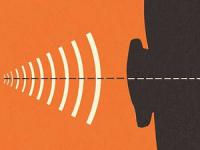-
Do we need a moratorium on germline gene editing?
In the wake of the news from China about He Jiankui’s gene-edited babies, many scientists are calling for a moratorium on germline gene-editing. Nature considered the topic sufficiently important to publish the call by several top researchers and ethicists for a moratorium.
-
-
Human brains vulnerable to voice morphing attacks

A recent research study investigated the neural underpinnings of voice security, and analyzed the differences in neural activities when users are processing different types of voices, including morphed voices.The results? Not pleasing to the ear. Or the brain.
-
-
New layer of medical preparedness to combat emerging infectious disease
Researchers supporting the PREventing EMerging Pathogenic Threats PREEMPT program will model viral evolution in animal populations, quantify the probability of human pathogen emergence, and pursue proof-of-concept interventions to prevent viral spread to humans.
-
-
Next-generation grid security tech
Researchers will demonstrate the effectiveness of metro-scale quantum key distribution (QKD) as a means of secure communication for the nation’s electricity suppliers. This initial milestone is part of the team’s three-year project focused on next-generation grid security.
-
-
Don’t be fooled by fake images and videos online

Advances in artificial intelligence have made it easier to create compelling and sophisticated fake images, videos and audio recordings. Meanwhile, misinformation proliferates on social media, and a polarized public may have become accustomed to being fed news that conforms to their worldview. All contribute to a climate in which it is increasingly more difficult to believe what you see and hear online. There are some things that you can do to protect yourself from falling for a hoax. As the author of the upcoming book Fake Photos, to be published in August, I’d like to offer a few tips to protect yourself from falling for a hoax.
-
-
Gain-of-function (GoF) research set to resume, and unease grows

Gain-of-function (GoF) research involving H5N1 is set to resume – but without review comments, as the review panel has kept mum. Many scientists are worried, arguing that certain studies that aim to make pathogens more potent or more likely to spread in mammals are so risky they should be limited or even banned.
-
-
Producing vaccines without the use of chemicals
Producing vaccines is a tricky task – especially in the case of inactivated vaccines, in which pathogens must be killed without altering their structure. Until now, this task has generally involved the use of toxic chemicals. Now, however, an innovative new technology developed by Fraunhofer researchers – the first solution of its kind – will use electron beams to produce inactivated vaccines quickly, reproducibly and without the use of chemicals.
-
-
China exerting “sharp power” influence on American institutions
China is penetrating American institutions in ways that are coercive and corrupt, while the United States has not fully grasped the gravity of the situation, a Hoover Institution expert says. “An ultimate ambition for global hegemony” is driving China’s multifront efforts to manipulate US state and local governments, universities, think tanks, media, corporations, and the Chinese American community, said Larry Diamond, a senior fellow at Hoover.
-
-
To find life beyond Earth,"take off the blinkers": Expert
Is there life beyond Earth? Recent discoveries point to tantalizing possibilities. But to understand the possibilities, we have to do one important thing: Stop thinking that life as we know it – that which depends on oxygen – is the only kind of life.
-
-
Significance vulnerabilities discovered in high-performance computer chips
Researchers have uncovered significant and previously unknown vulnerabilities in high-performance computer chips that could lead to failures in modern electronics. The researchers found they could damage the on-chip communications system and shorten the lifetime of the whole computer chip significantly by deliberately adding malicious workload.
-
-
Insect Allies: Friend or foe?
In 2016 DARPA launched the Insect Allies project, budgeting $45 million over four years to transform agricultural pests into vectors that can transfer protective genes into plants within one growing season. Scientists are concerned that such technology might be used for nefarious purposes. In a recent Science article, the scientists note the profound implications of releasing a horizontal environmental genetic alteration agent – implications that touch on regulatory, economic, biological, security, and societal issues.
-
-
Discovering new molecules for military applications
The efficient discovery and production of new molecules is essential for a range of military capabilities—from developing safe chemical warfare agent simulants and medicines to counter emerging threats, to coatings, dyes, and specialty fuels for advanced performance. Current approaches to develop molecules for specific applications, however, are intuition-driven, mired in slow iterative design and test cycles, and ultimately limited by the specific molecular expertise of the chemist who has to test each candidate molecule by hand. DARPA’s Accelerated Molecular Discovery (AMD) program aims “to speed the time to design, validate, and optimize new molecules with defined properties from several years to a few months, or even several weeks,” DARPA says.
-
-
Expanding the search for life in the universe
To advance the search for life in the universe, NASA should support research on a broader range of biosignatures and environments, and incorporate the field of astrobiology into all stages of future exploratory missions, says a new report from the National Academies of Sciences.
-
-
Ramping up fight against antimicrobial resistance
The U.S. government is challenging world leaders, corporations, and non-governmental groups to step up their efforts against antimicrobial resistance (AMR). The AMR Challenge asks for at least one commitment in one of five areas: improving antibiotic use in humans and animals; reducing antibiotics and resistant bacteria in the environment; developing new antibiotics, vaccines, and diagnostics; enhancing data collection and sharing; and improving infection prevention and control.
-
-
If there are intelligent aliens, why have we not we seen them?
Thousands of planets have been discovered in the last few decades, although astronomers tell us there are probably billions. In such a large and diverse set of solar systems, it seems impossible that humans could be the only intelligent life. This contradiction – between the high probability that life exists elsewhere in the universe and the lack of evidence for it – is known as Fermi’s Paradox. Coined by physicist Enrico Fermi in the 1960s, it’s a mystery that continues to invite consideration more than half a century later.
-
More headlines
The long view
A Shining Star in a Contentious Legacy: Could Marty Makary Be the Saving Grace of a Divisive Presidency?
While much of the Trump administration has sparked controversy, the FDA’s consumer-first reforms may be remembered as its brightest legacy. From AI-driven drug reviews to bans on artificial dyes, the FDA’s agenda resonates with the public in ways few Trump-era policies have.
Foundation for U.S. Breakthroughs Feels Shakier to Researchers
With each dollar of its grants, the National Institutes of Health —the world’s largest funder of biomedical research —generates, on average, $2.56 worth of economic activity across all 50 states. NIH grants also support more than 400,000 U.S. jobs, and have been a central force in establishing the country’s dominance in medical research. Waves of funding cuts and grant terminations under the second Trump administration are a threat to the U.S. status as driver of scientific progress, and to the nation’s economy.
The True Cost of Abandoning Science
“We now face a choice: to remain at the vanguard of scientific inquiry through sound investment, or to cede our leadership and watch others answer the big questions that have confounded humanity for millennia —and reap the rewards.”
